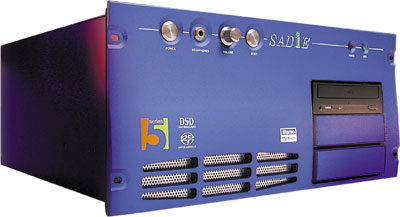Using their existing 2-channel Direct Stream Digital editing and authoring platform as a launching pad, SADiE has introduced an entire range of new workstations, known as the Series 5. Rolled out to the public at the recent AES Convention, the Series 5 comprises four new products, two PCM-based plus two additionally supporting DSD functionality, including the flagship DSD8, a multichannel DSD/Super Audio CD editing, mastering, and authoring workstation.

Differentiating the new Series 5 products from its predecessors, SADiE has not only beefed-up the hardware to include powerful new high-speed processing to cope with the high-resolution formats for which they were designed, but also performed a radical makeover on the exterior. Gone is the functional look of the older workstations, and in its place is a sleek new blue livery that in turn is complemented by the stylish new-look Version 5 software user interface.
The top-of-the-line DSD8 is the first workstation that combines multichannel DSD editing, mastering, and authoring functionality to be made commercially available. The platform offers what the company describes as true 64fs processing, that is, at a sampling frequency of 64 times 44.1 kHz or 2.8224 MHz, as opposed to other systems that down- and up-convert in order to process in the PCM domain.
The DSD8 incorporates the new hardware platform that it shares with the other Series 5 products while offering extended capabilities beyond the DSD2, a stereo version that replaces the companys current 2-channel DSD workstation. The DSD2, the companys entry-level DSD platform, is upgradeable to the DSD8.
The DSD8, like the DSD2, supports full editing and mastering of 64fs DSD signals and incorporates Super Audio CD authoring facilities that allow the production of both Scarlet Book cutting masters and CD Red Book masters. DST (Direct Stream Transfer), the lossless coding algorithm the SACD equivalent of MLP for DVD-A developed to maximize disc storage capacity in mastering, is also included, and will support compression of eight channels simultaneously.
Unlike the DSD2, the DSD8 is capable of playing 16 simultaneous DSD streams, allowing the concurrent recording of eight tracks while replaying eight edited tracks. This is in addition to the PCM streams required for control of the DSD processing. Integrated multi-band Annex D&E metering provides visual monitoring of the DSD signals. Mixer functionality extends to 4-band EQ per channel plus dynamics, level, and panning control.
The PCM hardware incorporated within the DSD8 and DSD2 platforms allows them to also function as powerful PCM editors. SADiE has included PCM editing software and eight channels of 192 kHz I/O PCM capability on the DSD workstations, which the company intends to bundle with an optional AIT drive and Adaptec SCSI bus as a turnkey CD/SACD mastering system.
PCM-only releases from SADiE include the PCM8, which replaces the existing 2496 recording, editing, and mastering system, and the entry-level PCM4, which replaces the RADiA workstation while offering a greatly enhanced feature set, operation at up to 96 kHz, and increased processing power to its target radio production market. The PCM8 is similar to the PCM4 except for its 8-channel I/O capability and support of sample rates up to 192 kHz. Both models include single-wire AES interfacing.
The core operating system of the new PCM and DSD platforms is SADiEs new Version 5 software, which has been designed specifically for the Series 5 hardware. The user interface has been completely redesigned to create an onscreen display with a contemporary look that complements the distinctive appearance of the new hardware. For those more comfortable with the handling of the older V4 interface, a user-selectable option allows operators to switch back to the classic GUI on the new platform.
Version 5 software introduces some significant new features, including DirectX realtime plug-in support, standard Windows networking, and a number of other enhancements and cosmetic upgrades. The software is exclusive to the Series 5, and therefore not backward compatible, but SADiE has made it possible to save V5 EDLs in the V4 format.
In addition to the traditional SADiE editing methods, the company has introduced 3-point and 4-point editing in V5 in response to customers coming to the system from other platforms that support those paradigms. Traditionally in a SADiE system, material held in the Source playlist is copied as a segment into the desired position in a Destination playlist, which becomes the master edit.
Legacy users are not entirely left out in the cold. At the AES show, SADiE also announced the release of the latest Version 4 software, V4.3, for existing owners. V4.3 incorporates the new 3- and 4-point editing features plus other enhancements.
SADiE has been working closely with leading third-party plug-in developers such as Waves, TC Electronic, and Antares to bring DirectX compatibility to the new Series 5 platform. The result is a new process that enables DirectX plug-ins to be loaded directly into the mixer strip for realtime playback or non-realtime bouncing through the mixer. V5 software includes a new DirectX command in the Process Palette Toolbar, while delay problems introduced by the processors are avoided through built-in automatic latency controls.
SADiEs new Series 5 systems are scheduled to ship before the end of the year. Prices are expected to be comparable to the companys existing workstations.
For more information, contact SADiE at 615-327-1140 or visit www.sadie.com.


